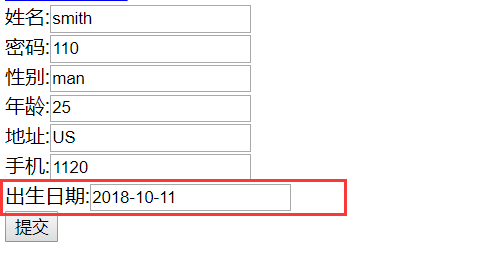1. 接受的参数为日期类型
如何接受日期类型格式的参数?
(1)接受单个日期参数
网页输出:

//后台接受参数为日期类型
@RequestMapping("toDate.do")
public String toDate(Date date) {
System.out.println(date);
return "index";
}
使用initBinds 加入到UsersController.java 当你接受的参数日期类型时先经过该方法进行处理
@InitBinder
public void initBinder(ServletRequestDataBinder binder){
//只要网页中传来的数据格式为yyyy-MM-dd 就会转化为Date类型
binder.registerCustomEditor(Date.class, new CustomDateEditor(new SimpleDateFormat("yyyy-MM-dd"), true));
}
(2)接受多个参数时
网页输出:

// 注册页面 register.jsp
<%@ page language="java" contentType="text/html; charset=UTF-8" pageEncoding="UTF-8"%>
<!DOCTYPE html PUBLIC "-//W3C//DTD HTML 4.01 Transitional//EN" "http://www.w3.org/TR/html4/loose.dtd">
<html>
<head>
<meta http-equiv="Content-Type" content="text/html; charset=UTF-8">
<title>Insert title here</title>
</head>
<body>
<a href="users/register.do?name=zs&age=25">链接到list.do</a>
<form action="users/register.do" method="post">
姓名:<input type="text" name="unames"/><br>
密码:<input type="text" name="password"/><br>
性别:<input type="text" name="sex"/><br>
年龄:<input type="text" name="age"/><br>
地址:<input type="text" name="address"/><br>
手机:<input type="text" name="phone"/><br>
出生日期:<input type="text" name="birthday"/><br>
<input type="submit" value="提交"/>
</form>
</body>
</html>
//接受多个参数
@RequestMapping("register.do")
public String register(Users users) {
System.out.println(users);
return "index";
}
接受多个参数时直接在对应的实体类(bean)中加入

2.controller进行数据保存
2.1 数据保存到request作用域的方式.
jsp调用:${requestScope.name }
1.使用ModelAndView,那么该方法的返回类型必须是ModelAndView
//1.可保存到ModelAndView,那么方法的返回类型必须是ModelAndView
@RequestMapping("index.do")
public ModelAndView index() {
ModelAndView mv=new ModelAndView("index");
mv.addObject("name","张三");
return mv;
}
2.使用Model, 方法的返回值还是字符串类型。
//2.保存到Model中,方法的返回值还可以是字符串
@RequestMapping("index.do")
public String index(Model model) {
model.addAttribute("name","李四");
return "index";
}
3.使用Map.方法的返回值还是字符串类型
//3.保存到Map中
@RequestMapping("index.do")
public String index(Map<String,Object> map) {
map.put("name","王五");
return "index";
}
jsp调用:${sessionScope.name }
4.原始的HttpServletRequest对象保存
//4.原始的HttpServletRequest对象保存
@RequestMapping("index.do")
public String index(HttpSession session) {
session.setAttribute("name","田七");
return "index";
}
jsp调用:${applicationScope.name }
2.2 数据保存到session作用域的方式
1.使用原始的HttpSession保存
//1.使用原始的HttpSession保存。
@RequestMapping("index.do")
public String index(Model model,HttpSession session) {
//session.getServletContext():得到application对象
session.getServletContext().setAttribute("name","我在application中");
return "index";
}
2.使用注解@SessionAttributes(name={key1,key2})

3. 静态资源的映射关系。


静态资源可以正常的显示


需要在springmvc的配置文件中添加

4.Springmvc完成ajax功能
1.加入jackson的jar包. springmvc
2.在响应的方法上加上@ResponseBody :把java对象转化为json对象
3.方法的返回值可以是对象集合字符串。

4.如果ajax返回的为字符串,那么就会出现乱码。
因为:



修改:
